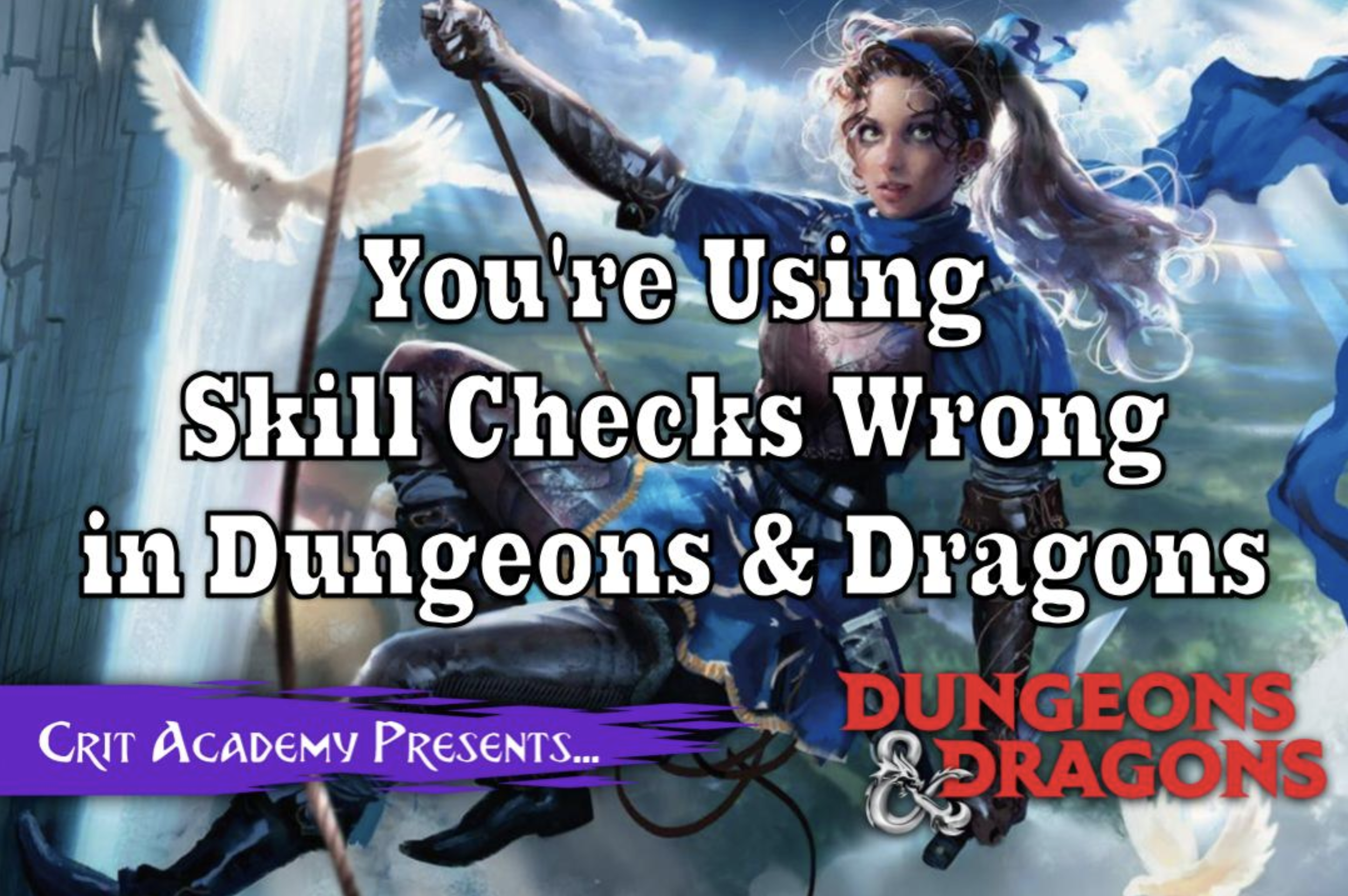You're Using Skill Checks Wrong: How to Use Skill Checks in Dungeons & Dragons
Art: Compliments of Wizards of the Coast
Do you want to be a better D&D Player? Do you want to be a better D&D Player? Do you want to become an amazing Dungeon Master? Then subscribe to our YouTube to get notified when we publish new D&D Tips and Tricks videos
Satisfying Dungeons & Dragons stories differ from other narrative forms in one major way: D&D stories don’t follow a single predetermined storyline through a series of turning points. Instead, each turning point presents the opportunity for the story to branch in an unexpected direction. By anticipating branches, you can ensure that the story keeps moving in an exciting and unexpected direction.
A strong branch point engages players and can move the story in two or more directions. In this blog, we discuss in great detail leveraging dice rolls to create story branches that enhance the game regardless of the success or failure of the roll.
Each roll of the skill check in D&D should create a new branch in the story
When you call for a check as Dungeon Master, you determine an action that affects the story. Essentially creating a pass/fail branching point.
A successful check lets the PCs pass the challenge and gain a benefit. Often releasing any tension built up. This carries them to the next turning point.
When they fail a check or flee they fail the encounter and should suffer any negative consequences. When you do this, the outcome should increase tension in some way. Then it should still carry them to the next turning point, even one not of their choosing, but instead a result of the roll.
One of the most common examples is a rogue picking a lock and failing their check. Do you continue to ask for checks until they succeed? No! Instead push the story forward. The check represents the PC’s ability to deal with that particular lock. There could be a number of reasons they were unable to pick it. For example:
Perhaps something in the lock breaks during the picking process.
Something inside is rusted or damaged that prevents it from being picked.
Maybe the rogue has never worked on this type of lock before.
Possibly it's tamper-proof.
In this case, they cannot proceed through the door with lock picking. Regardless of the reason, a branch that has a null result and doesn’t move the story forward, can cause players frustration. Keep in mind, if the players are unable to overcome a roadblock, there should always be another branch for them to take. Or some other event that is triggered as a result.
In the example with the lock pick, perhaps while they are picking it, a patrolling guard passes by and catches them. On his person is a key to the door they are trying to enter. On the other hand, maybe the barbarian just knocks the door down or the wizard blows it up. Perhaps there is just another way around through a different passage.
Art: Compliments of Wizards of the Coast
Create strong pass/fail branch points and build up that tension
A great example of this is a timely classic, crossing a chasm on a tight rope. It's extremely obvious in this case what failure means. Likely death, or at the very least, a long trek back up the chasm. Let them know the dangers of failure. In the lock picking example, it could be gradual footfalls of the guard echoing off the stone as they are getting closer as they start their skill check.
Avoid dead branches in your story
When looking at the outcome of two branch points, don’t let either lead to a narrative dead end. This occurs most often when PCs can’t devise a solution to a problem or with very frequent and petty obstacles are in their path with no real consequence of failure. Every roll should be important and have an obvious outcome and potential consequence.
If you are unable to device a consequence of failure that can take the story anywhere, it’s ok to allow the players an automatic success
Sometimes the players get lucky and the guards are asleep at their post. Perhaps the bandits they stumble upon just robbed a wagon full of ale and are in a drunken stupor. Always do your best to turn all dead branches into a scene that moves the story forward.
Sign Up for our newsletter to get a FREE copy of our best-selling D&D Supplement: Challenge Accepted. You will also be entered to win our weekly RPG PhatLoot Giveaways!
Make sure to subscribe to our newsletter so we can help you on your future adventures. Newsletter subscribers are also entered to win cool prizes each and every week. Check out our fellowship members for more great content. Visit our Youtube channel for our show episodes, actual play episodes, and our tips & tricks videos. Support us on Patreon to get weekly Dungeons and Dragons loot!
Branch Encounters
The aftermath of most encounters has two or more branches. Lucky and smart players can often walk away from an encounter without expending too many resources. Bad luck or poor tactics, in the same way, can leave the PCs in worse shape and force them to rest to replenish their resources. In the worst-case scenario, one or more PCs die during the encounter exacting a much higher cost and loss of time.
You can turn these encounters into genuine pass/fail turning points with possible branches for both outcomes. A common example is building a much more difficult encounter against superior opponents. A simple outline like below can help with these.
Success in a challenge leads to branch C that leads to their goal.
Failure in the challenge leads to branch B that contains another challenge that they must succeed through before they reach desired branch C.
Both get you there, but a group luckier or playing smarter will get there sooner and with more resources. Additionally, you can have a secondary goal, if achieved in a certain number of rounds, hours, days etc, the encounter takes a positive turn
Success, taking out the dashing kobold before any others prevents reinforcements from arriving later in the fight.
Failure, reinforcements show up making the encounter much more deadly.
Make sure to tailor the branches to each encounter adjusting difficulty if necessary.
Branching Decisions
Strongly plotted adventures provide players with a multitude of opportunities to make decisions that generate branch points for the story. Not all branching is combat-related. Normal interactions also cause branching, for example:
Which door to go through, choosing an NPC to talk to, demanding to speak with a noble to name a few.
Players often make unexpected choices. Often a DM who prefers to have completely fleshed out stories and encounters will often try to nullify a players’ choice and encourage them to return to their script. This is certainly something we should avoid when we can, as it removes player agency.
A DM who can improvise might often let that players’ choice become an opportunity to take the story in a new direction. Strong decision branches give the players a sense of freedom and influence over events. When a decision branch lies between action and inaction, heighten the stakes by making both options seem appealing in different ways. For example, a dungeon corridor to the left may smell of rotting flesh and necrotic magic, while the corridor to the right may have an echo of an enchanting and alluring harpy’s song.
No matter what decisions the PCs make in your stories. When you call for a check, always consider how the roll will branch the story in a fun and interesting way. The unpredictable nature of checks is one of roleplaying's greatest strengths.
Unearthed Tips and Tricks Monthly Magazine! We bring you new and creative content for you to bring with you on your next adventure
If you're interested in advertising with us, click here to learn more.
*Crit Academy is an Affiliate of Amazon, DMsguild and DriveThruRPG*






